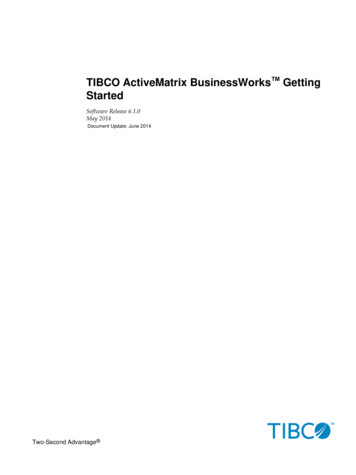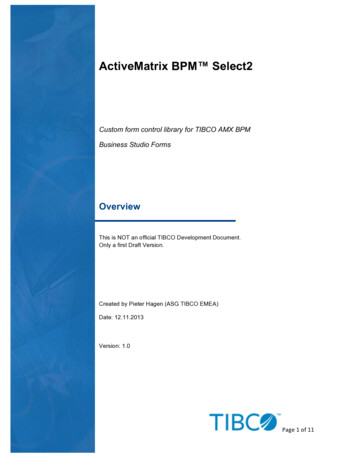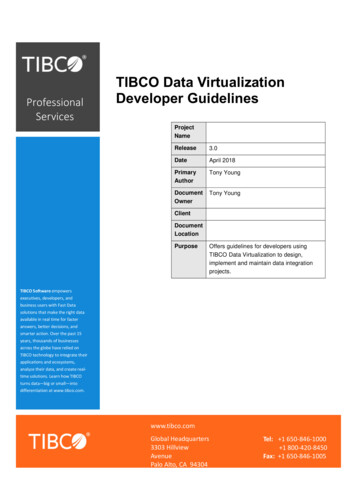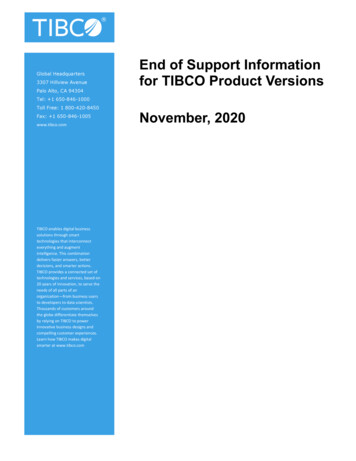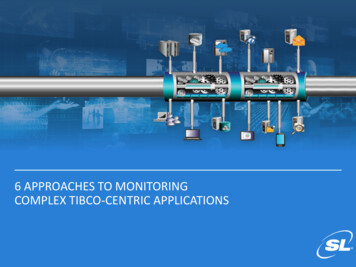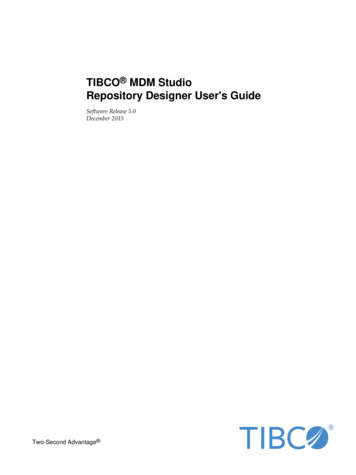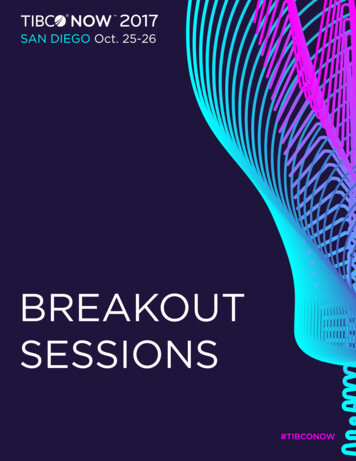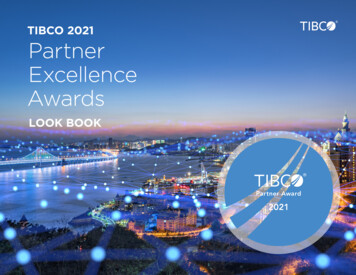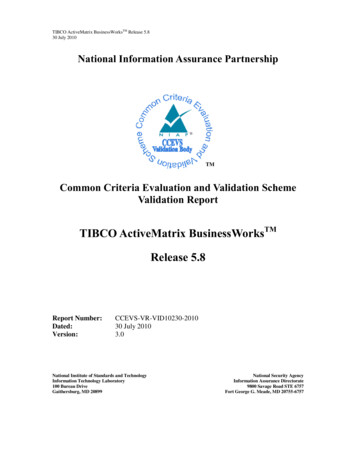
Transcription
TIBCO ActiveMatrix BusinessWorksTM Release 5.830 July 2010National Information Assurance Partnership TMCommon Criteria Evaluation and Validation SchemeValidation ReportTIBCO ActiveMatrix BusinessWorksTMRelease 5.8Report Number:Dated:Version:CCEVS-VR-VID10230-201030 July 20103.0National Institute of Standards and TechnologyInformation Technology Laboratory100 Bureau DriveGaithersburg, MD 20899National Security AgencyInformation Assurance Directorate9800 Savage Road STE 6757Fort George G. Meade, MD 20755-6757
TIBCO ActiveMatrix BusinessWorksTM Release 5.830 July 2010ACKNOWLEDGEMENTSValidation TeamDr Patrick Mallett (Lead Validator)Olin Sibert (Senior Validator)Common Criteria Testing LaboratoryTerrie Diaz, Lead EvaluatorScience Applications International Corporation (SAIC)Columbia, Marylandii
TIBCO ActiveMatrix BusinessWorksTM Release 5.830 July 2010Table of Contents123456Executive Summary . 4Identification . 5Organizational Security Policy . 6Assumptions and Clarification of Scope. 8Architectural Information . 9Documentation . 116.1Design documentation . 116.2Guidance documentation (this documentation is delivered with the TOE) . 116.3Lifecycle documentation . 126.4Test documentation . 126.5Security Target . 137 IT Product Testing . 137.1Developer Testing . 137.2Evaluation Team Independent Testing . 137.3Vulnerability Testing . 148 Evaluated Configuration . 149 Results of the Evaluation . 189.1Evaluation of the TIBCO ActiveMatrix BusinessWorks Release 5.8 SecurityTarget (ST) (ASE). 189.2Evaluation of the Development (ADV) . 189.3Evaluation of the guidance documents (AGD) . 199.4Evaluation of the Life Cycle Support Activities (ALC) . 199.5Evaluation of the Test Documentation and the Test Activity (ATE) . 209.6Vulnerability Assessment Activity (AVA) . 209.7Summary of Evaluation Results. 2010Validator Comments/Recommendations . 2011Security Target . 2012Glossary . 2013Glossary of Terms . 2114Bibliography . 21iii
TIBCO ActiveMatrix BusinessWorksTM Release 5.830 July 20101 Executive SummaryThis report documents the National Information Assurance Partnership (NIAP) assessmentof the evaluation of the TIBCO ActiveMatrix BusinessWorksTM Release 5.8.The Validation Report presents the evaluation results, their justifications, and theconformance results. This Validation Report is not an endorsement of the Target ofEvaluation (TOE) by any agency of the U.S. Government and no warranty of the TOE iseither expressed or implied.The evaluation of TIBCO ActiveMatrix BusinessWorks Release 5.8 was performed byScience Applications International Corporation (SAIC) Common Criteria TestingLaboratory in the United States and was completed on 25 May 2010.The information in this report is largely derived from the Security Target (ST), EvaluationTechnical Report (ETR) and associated test report. The ST was written by SAIC. TheETR and Team Test Report used in developing this validation report were written by SAIC.The evaluation team determined the product to be Part 2 and Part 3 conformant, and meetsthe assurance requirements of EAL 2 augmented with ALC FLR.2. All security functionalrequirements are derived from Part 2 of the Common Criteria.The TOE is TIBCO ActiveMatrix BusinessWorks Release 5.8 provided by TIBCOSoftware Inc. ActiveMatrix BusinessWorks is what is called an “integration server” thatprovides a runtime environment for distributed multi-tier enterprise applicationsThe evaluation has been conducted in accordance with the provisions of the NIAPCommon Criteria Evaluation and Validation Scheme and the conclusions of the testinglaboratory in the evaluation technical report are consistent with the evidence adduced.During this validation, the Validators determined that the evaluation showed that theproduct satisfies all of the functional requirements and assurance requirements defined inthe Security Target (ST). Therefore, the Validator concludes that the SAIC findings areaccurate, the conclusions justified, and the conformance claims correct.4
TIBCO ActiveMatrix BusinessWorksTM Release 5.830 July 20102 IdentificationThe CCEVS is a joint National Security Agency (NSA) and National Institute of Standardsand Technology (NIST) effort to establish commercial facilities to perform trusted productevaluations. Under this program, commercial testing laboratories called Common CriteriaTesting Laboratories (CCTLs) using the Common Evaluation Methodology (CEM) forEvaluation Assurance Level (EAL) 1 through EAL 4 in accordance with NationalVoluntary Laboratory Assessment Program (NVLAP) accreditation.The NIAP Validation Body assigns Validators to monitor the CCTLs to ensure quality andconsistency across evaluations. Developers of information technology products, desiring asecurity evaluation, contract with a CCTL and pay a fee for their product‟s evaluation.Upon successful completion of the evaluation, the product is added to NIAP‟s ValidatedProducts List.Table 1 provides information needed to completely identify the product, including:The Target of Evaluation (TOE): the fully qualified identifier of the product asevaluated;The Security Target (ST), describing the security features, claims, and assurances ofthe product;The conformance result of the evaluation;The Protection Profile to which the product is conformant; andThe organizations and individuals participating in the evaluation.Table 1: Evaluation IdentifiersItemIdentifierEvaluationSchemeUnited States NIAP Common Criteria Evaluationand Validation SchemeTOE:TIBCO ActiveMatrix BusinessWorksTM Release5.8Protection Profile NoneST:TIBCO ActiveMatrix BusinessWorks Release5.8 Security Target, Version 2.0, August 18, 2010EvaluationTechnicalReportEvaluation Technical Report for TIBCOActiveMatrix BusinessWorksTM Release 5.8, Part 1(Non-Proprietary), Version 3.0, 30 July 2010, Part 2(Proprietary), Version 3.0, 7 July 2010, andSupplemental Team Test Report, Version 2.0, 7July 2010.5
TIBCO ActiveMatrix BusinessWorksTM Release 5.830 July 2010ItemIdentifierCC VersionCommon Criteria for Information Technology SecurityEvaluation, Version 3.1, Revision 2, September 2007ConformanceResultCC Part 2 and Part 3 conformant, EAL 2 augmented withALC FLR.2SponsorTIBCO Software IncDeveloperTIBCO Software IncCommonCriteria TestingLab (CCTL)Science Applications International Corporation(SAIC), Columbia, MDCCEVSValidatorDr Patrick Mallett (Lead Validator),mallett@mitre.orgOlin Sibert (Senior Validator),osibert@orionsec.com3 Organizational Security PolicyThe Target of Evaluation (TOE) is TIBCO ActiveMatrix BusinessWorks Release 5.8 (alsoknown as ActiveMatrix BusinessWorks). Active Matrix BusinessWorks consists of adevelopment application, an administration application, and a runtime integration engine.These applications utilize common libraries. The following are the software applicationsthat make up the TOE.TIBCO DesignerTM – Provides the ability to develop business processes.TIBCO AdministratorTM – Provides administrative interfaces that can be used tomanage services of the TOE and business processes.TIBCO ActiveMatrix BusinessWorksTM – Provides a runtime environment forbusiness processes.TIBCO Runtime AgentTM – Provides common functionality in libraries used byActiveMatrix BusinessWorks applications, including functions used tocommunicate between TOE components.Below in Figure 2.1 depicts a very general view of the components that make up theTIBCO product. The TIBCO Designer application creates and deploys a definition of abusiness process and then plays no part in the operation of the deployed business process.6
TIBCO ActiveMatrix BusinessWorksTM Release 5.830 July 2010The TIBCO Administrator application and TIBCO ActiveMatrix BusinessWorks engineeach include an instance of TIBCO Runtime Agent.The TIBCO Designer application creates an Enterprise Archive (EAR) file to describe abusiness process and associated resource information; in conjunction with the TIBCODesigner application, certain properties may be included in an XML file called„bwengine.xml‟. Certain aspects of the design elements and all of the aspects of thebwengine.xml file are exposed to the TIBCO Administrator application and may bechanged prior to deployment.TIBCO Designer ApplicationDeploymentTIBCO Runtime AgentTIBCO AdministratorApplicationOperationalTIBCO Runtime sEngineEngineTIBCO re 2 1 TIBCO ComponentsTIBCO Runtime Agent is installed on all machines in the network that are participating inthe business process.These EAR files are moved1 from the TIBCO Designer application to the TIBCOAdministrator application. The TIBCO Administrator application is then used to deployapplicable parts of the EAR file to applicable instances of the TIBCO ActiveMatrixBusinessWorks engine. The TIBCO Administrator application starts the ActiveMatrixBusinessWorks engine to perform activities in the business process.1The method of moving an EAR file depends upon administrative and physical concerns and is outside thescope of this security target.7
TIBCO ActiveMatrix BusinessWorksTM Release 5.830 July 2010TIBCO Runtime Agent is an installation package that provides common functionality inlibraries used by other ActiveMatrix BusinessWorks applications, including functions usedto communicate between TOE components. Two significant pieces of TIBCO RuntimeAgent are subsets of other TIBCO products: TIBCO Hawk Agent and TIBCORendezvous Daemon. Hawk Agent is configured for a business process (created by theDomain Utility) to use either Rendezvous or TIBCO Enterprise Message Service as amessage carrying protocol to pass messages between subsystems. Hawk Agent is used byeach subsystem to facilitate communication between subsystems while enforcingconstraints defined for the business process. Rendezvous Daemon-based communicationprovides message passing similar to message passing using the TCP/IP based socketprogramming construct. Rendezvous is a connection-less, transport layer protocol carriedby UDP/IP packets. The TIBCO Designer application, the TIBCO Administratorapplication, and the ActiveMatrix BusinessWorks engine all rely upon software installedby TIBCO Runtime Agent.The TOE supports creation of the business process, however, the security requirementdescribed in the ST define the protections that are available once the business process hasbeen deployed.4 Assumptions and Clarification of ScopeThe statement of TOE security environment describes the security aspects of theenvironment in which it is intended that the TOE will be used and the manner in which it isexpected to be employed. The statement of TOE security environment therefore identifiesthe assumptions made on the operational environment and the intended method for theproduct and defines the threats that the product is designed to counter.Following are the assumptions identified in the Security Target:It is assumed the TOE will be located within controlled access facilities, which willprevent unauthorized physical access.It is assumed there will be one or more competent individuals assigned to managethe TOE and the security of the information it contains.It is assumed authorized administrators are not careless, willfully negligent, orhostile, and will follow and abide by the instructions provided by the TOEdocumentation.It is assumed the environment will provide a reliable time stamp for use by theTOE.It is assumed the access controls provided by the operating system in theenvironment will be used to ensure that commands to set up the TOE are used onlyby users associated with establishing the operational TOE.It is assumed a tool will be provided by the environment to allow administrators tomodify TOE text-based configuration data during set up to achieve the evaluatedconfiguration (e.g., FIPS mode).8
TIBCO ActiveMatrix BusinessWorksTM Release 5.830 July 2010Following are the threats levied against the TOE and its environment as identified in theSecurity Target. The threats that are identified are mitigated by the TOE and itsenvironment. All of the threats identified in the ST are addressed.An administrator may not be held accountable for their actions.An unauthorized user, process, or external IT entity may masquerade as anauthorized entity to gain access to data or TOE resources.An unauthorized external IT entity may inappropriately access or modify inboundor outbound messages by intercepting it while it is in transit across a network.An unauthorized external IT entity or malicious user may inappropriately accessTSF data by intercepting it while it is in transit across a network.The TOE is TIBCO ActiveMatrix BusinessWorks Release 5.8 (also known asActiveMatrix BusinessWorks). Active Matrix BusinessWorks consists of a set of softwareapplications that allow administrators to create and then host business processes that areaccessed by other systems, that may access other systems, and which may be accessed byusers; it is mainly used as an integration platform.5 Architectural InformationThis section provides a high level description of the TOE and its components as describedin the Security Target.As described above, the following are the software applications that make up the TOE.TIBCO Designer – Provides the ability to develop business processes.TIBCO Administrator – Provides administrative interfaces that can be used tomanage services of the TOE and business processes.TIBCO ActiveMatrix BusinessWorks – Provides a runtime environment forbusiness processes.TIBCO Runtime Agent – Provides common functionality in libraries used byActiveMatrix BusinessWorks applications, including functions used tocommunicate between TOE components.The TIBCO Designer application, the TIBCO Administrator application, the TIBCOActiveMatrix BusinessWorks engine, and TIBCO Runtime Agent can be installed onseparate computers in a network or combined on the same computer as appropriate for theenvironment and for the business process. TIBCO Runtime Agent must be installed as partof each TIBCO software application because it provides common functionality in librariesthat are used by other parts of the product.TIBCO DesignerThe TIBCO Designer application is an application used to create the definition of abusiness process. This definition is represented in a set of files (EAR files) that must be9
TIBCO ActiveMatrix BusinessWorksTM Release 5.830 July 2010transferred to computers on a network in order for the business process to be madeavailable to end users (i.e., users of the business process). All of the computers in anetwork that are intended to support a business process are considered to be part of thesame „domain‟. A „domain‟ is an administrative grouping of computer systems runningin support of a business process.The EAR files must be moved from the TIBCO Designer application to a TIBCOAdministrator application in a domain. The TIBCO Administrator application is thenused to deploy applicable parts of the EAR files to applicable instances of theActiveMatrix BusinessWorks engine. The TIBCO Administrator application starts theActiveMatrix BusinessWorks engines to perform activities in the business process.The TIBCO Designer application does not implement any security features and playsno role in the enforcement of security checks in a deployed business process. Themethod of moving an EAR file from a TIBCO Designer application to a TIBCOAdministrator application depends upon administrative and physical concerns and isoutside the scope of the TIBCO Designer application. Access to the application that isthe TIBCO Designer subsystem and to data files used by and created by the TIBCODesigner subsystem is controlled by the operating system that is part of the ITenvironment of the TOE.TIBCO AdministratorThe TIBCO Administrator application is used by trusted individuals to performadministration activities for the TOE and for business processes executing on the TOE.Installation of TIBCO Administrator leads to the creation of a domain. The TIBCOAdministrator application is responsible only for enforcing constraints uponmanagement of a business process and of a domain, auditing those activities andpropagating configuration changes to other applications.The ActiveMatrix BusinessWorks engineThe initial configuration of a business process is provided by the TIBCO Designerapplication in the EAR files that describe the business process. Selected configurationvalues (those specified by the TIBCO Designer application as externalized) can bemodified by the TIBCO Administrator application. The ActiveMatrix BusinessWorksengine uses whatever configuration values are provided to it when the business processis deployed or when the TIBCO Administrator application indicates a configurationchange.One or more ActiveMatrix BusinessWorks engines must exist in a network runningTIBCO ActiveMatrix BusinessWorks.TIBCO Runtime AgentTIBCO Runtime Agent is required for any machine that will participate in a businessprocess whether it is a TIBCO Designer application, a TIBCO Administratorapplication, or an ActiveMatrix BusinessWorks engine. Machines performingenvironmental supporting duties (e.g., a DBMS, an LDAP server) do not need to have aTIBCO Runtime Agent installation.The TIBCO Runtime Agent installation package includes the following pieces.10
TIBCO ActiveMatrix BusinessWorksTM Release 5.830 July 2010Rendezvous Daemon provides real-time messaging between applications;Hawk Agent provides distributed monitoring and management of a businessprocess.A Java Runtime Environment in which other applications execute and whichprovides a reliable timestamp for use by the TOE;TIBCO developed libraries (e.g., TIBCrypt library that provides encryptionfeatures);3rd Party libraries (e.g., The Entrust library that provides FIPS compliantencryption features );A Domain Utility that manages domains anddomain; andmanages machines within aA TIBCO Designer application that provides basic business process designfeatures.Administration DomainAn “administration domain” is a collection of users, machines, and services that iscreated during initial TOE installation and configuration that will be controlled as a set(e.g., the Accounting Department administration domain, the R&D administrationdomain). Each domain is managed by a TIBCO Administrator application, which canthen be used by administrators to manage TOE functions. Administrators can only loginto TOE instances belonging to the same administration domain in which theiraccount is defined.6 DocumentationFollowing is a list of the evaluation evidence, each of which was issued by the developer(and sponsor).6.16.2Design documentationDocumentVersion2DateTIBCO High-Level DesignRevision 0.8May 25, 2010Guidance documentation (this documentation is delivered with the TOE)DocumentVersionTIBCO ActiveMatrix BusinessWorks (5.8),TIBCO Administrator (5.6),TIBCO Runtime Agent (5.6) SecurityFeatures User‟s GuideVersion 1.9TIBCO ActiveMatrix BusinessWorks2Date14 May 2010Several versions of certain documents were examined in the course of the evaluation, and updates weremade as the evaluation proceeded. The referenced version satisfies all evaluation requirements. Where noversion number is specified, no updates were needed to satisfy evaluation requirements.11
TIBCO ActiveMatrix BusinessWorksTM Release 5.830 July 2010Concepts, Software Release 5.8TIBCO ActiveMatrix BusinessWorks GettingStarted, Software Release 5.8TIBCO ActiveMatrix BusinessWorks ProcessDesign Guide, Software Release 5.8TIBCO ActiveMatrix BusinessWorks PaletteReference, Software Release 5.8TIBCO ActiveMatrix BusinessWorksAdministration, Software Release 5.8TIBCO ActiveMatrix BusinessWorksInstallation, Software Release 5.8TIBCO ActiveMatrix BusinessWorksError Codes, Software Release 5.8TIBCO ActiveMatrix BusinessWorks ReleaseNotes, Software Release 5.8TIBCO Administrator Release NotesSoftware Release 5.6.1TIBCO Administrator User GuideSoftware Release 5.6TIBCO Administrator ServerConfiguration Guide, Software Release 5.6TIBCO Administrator InstallationGuide, Software Release 5.6TIBCO Runtime Agent Release NotesSoftware Release 5.6TIBCO Runtime Agent Scripting DeploymentUser‟s Guide, Software Release 5.6TIBCO Runtime Agent Domain Utility User‟sGuide, Software Release 5.6TIBCO Runtime Agent Installing Into a ClusterSoftware Release 5.6TIBCO Runtime Agent InstallationSoftware Release 5.6TIBCO Runtime Agent Upgrading to Release 5.6Software Release 5.6TIBCO Designer User‟s GuideSoftware Release 5.6TIBCO Designer Palette ReferenceSoftware Release 5.6TIBCO Designer Release NotesSoftware Release 5.6.26.3February 2010February 2010February 2010February 2010February 2010February 2010February 2010February 2010July 2008July 2008July 2008July 2008July 2008July 2008July 2008July 2008July 2008July 2008July 2008January 2010Lifecycle documentationDocumentVersionTIBCO ActiveMatrix BusinessWorksConfiguration Management PlanVersion 0.5TIBCO Software, Inc. Delivery Procedures Revision 0.9Post-Release Management LifecycleVersion 0.56.4February 2010DateMarch 16, 2010February, 20109/17/2007Test documentationDocumentVersionDateAssurance Test Evidence TIBCOActiveMatrix BusinessWorks SuiteVersion 0.712 May 201012
TIBCO ActiveMatrix BusinessWorksTM Release 5.830 July 2010LINUX TESTS TIBCO ActiveMatrixBusinessWorks Suite6.5Version 0.712 May 2010Security TargetDocumentVersionDateTIBCO ActiveMatrix BusinessWorksRelease 5.8 Security TargetVersion 1.9July 7, 20107 IT Product TestingThis section describes the testing efforts of the developer and the Evaluation Team.7.1 Developer TestingThe developer tested the interfaces identified in the functional specification and mappedeach test to the security function, more specifically to the security functional requirementstested. The scope of the developer tests included all the TSFI. The testing covered thesecurity functional requirements in the ST including: Security Audit, User Data Protection,Identification and Authentication, Security Management, and Protection of the TSF. Allsecurity functions were tested and the TOE behaved as expected. The evaluation teamdetermined that the developer‟s actual test results matched the vendor‟s expected results.7.2 Evaluation Team Independent TestingThe evaluation team exercised the entire automated test suite and a subset of the vendor‟smanual test suite. The tests were run within three distinct domains.Domain A had Oracle 10g as the Domain Storage, Active Directory 2003 as theLDAP source, and it used Enterprise Message Service as the Domain Transport.ActiveMatrix BusinessWorks clients were tested on Windows and Linux, TIBCOAdministrator will be run on Windows Server 2008. The Port for TIBCOAdministrator was 18443. Active Directory, proFTP, and Oracle 10g wereconfigured to accept TLS/SSL communications with a single, well-knownCertificate Authority providing a chain-of-trust for the whole environment(cclabCA.pem). The TIBCO Administrator instance that defines this domain wasalso configured so that it would only accept TLS/SSL communications and requiredmutual X.509 authentication in addition to the ID/Passphrase during login.Domain B had SQL Server 2005 as the Domain Storage, Sun Directory Server 6.3as the LDAP source, and it used Rendezvous as the Domain Transport, configuredwith SSH. ActiveMatrix BusinessWorks clients were tested on Windows andLinux. TIBCO Administrator was run on the Linux system. The Port for TIBCOAdministrator was 18080. SQL Server 2005 and Sun Directory Server wereconfigured to accept TLS/SSL.Domain C consisted of TIBCO Administrator on the Linux system with anWindows XP client. Test cases were limited to testing access of domain data from13
TIBCO ActiveMatrix BusinessWorksTM Release 5.830 July 2010the file system – login information for TIBCO Administrator access as well as TOEuser access from an ActiveMatrix BusinessWorks process (Basic Authentication).All machines had the Unlimited Strength Jurisdiction Policy files applied to the JREresponsible for the TOE‟s Java runtime and had the X.509 PKI Chain-of-Trust enabled inthe JRE‟s “cacerts” file for purposes of performing TLS/SSL for LDAP services.In addition to developer testing, the evaluation team conducted its own suite of tests, whichwere developed independently of the sponsor. These also completed successfully.7.3 Vulnerability TestingThe evaluators developed vulnerability tests to address the Protection of the TSF securityfunction, as well as expanding upon the public search for vulnerabilities provided to theteam by the sponsor. These tests identified no vulnerabilities in the specific functionsprovided by the TOE.8 Evaluated ConfigurationThe intended environment of the TOE can be described in terms of the followingcomponents:Operating Systems – Provides a runtime environment for TOE applicationcomponents (not for distributed applications developed using the TOE) and areliable timestamp for use by the TOE.Storage Medium – Provides storage for TOE configuration information (e.g., filesor databases).Cryptomodule – Performs cryptographic operations on messages at the request ofthe TOE.Directory Service – Optionally provides storage for user identification andauthentication3 information that is used by the TOE when user authentication isrequired for a business process.Web Bbrowser – Provides a user interface for the TIBCO Administrator application.Enterprise Applications – Optional, applications providing access to data andfunctionality in the environment.The TOE can reside on either a single machine or on many machines in a network. TheTOE executes as applications that are accessed by users or other systems to implement abusiness process. Figure 8-1 shows the communication pathways that exist between usersor systems, the TIBCO Administrator application, the ActiveMatrix BusinessWorksengine, and controlled enterprise applications. Both the TIBCO Administrator applicationand ActiveMatrix BusinessWorks engine implement web servers. The communicationpathways labeled as “1st” and “2nd” in Figure 8-1 must be a HTTP request, HTTPS request,3A directory service is optional because identification and authentication material can be stored in operatingsystem file, a DBMS or in an LDAP server depending upon the definition of the „administration domain‟.14
TIBCO ActiveMatrix BusinessWorksTM Release 5.830 July 2010SOAP request, TCP/IP packet, Rendezvous messages, JMS message, or RMI call4. Thefollowing are some examples of these communication pathways.A user or system issues an HTTP request to the ActiveMatrix BusinessWorksengine and receives a response.A user or system issues a SOAP request to the ActiveMatrix BusinessWorks engineand receives a response.A user or system sends TCP/IP messages through the ActiveMatrix BusinessWorksengine and receives a responseThe communication pathway between two ActiveMatrix BusinessWorks engine occurswhen one business process activity on the first ActiveMatrix BusinessWorks enginecommunicates with another business process activity on a second ActiveMatrixBusinessWorks engine. These types of communication pathways include all of the samepathways as can be initiated by a user, but also include a pathway for fault toleranceprovided by the environment and is outside the scope of this evaluation. TIBCORendezvous messages5 can be passed between ActiveMatrix BusinessWorks engines tofacilitate fault tolerance.The “3rd” communication pathway is between ActiveMatrix BusinessWorks engines andcontrolled enterprise applications. These pathways include the same pathways as areavailable for user process to ActiveMat
TIBCO ActiveMatrix BusinessWorksTM - Provides a runtime environment for business processes. TIBCO Runtime AgentTM - Provides common functionality in libraries used by ActiveMatrix BusinessWorks applications, including functions used to communicate between TOE components. Below in Figure 2.1 depicts a very general view of the components that .

